|
Tracy Edwards, MBE, was captain of Maiden, the first all women's crew to race the Whitbread Around the World Regatta in 1989-1990. Her amazing story is told in the 2019 documentary film of the same name Maiden. Tracy has gone on to a distinguished maritime career, and in recent years, rebuilt Maiden and created a charitable foundation called the Maiden Factor Foundation, which is bringing the vessel and her inspiring story to people around the world. The organization raises funds for and works toward access to education for all girls and others who do not have access around the world. We encourage you to learn more and support the foundation here: www.themaidenfactor.org
The famous vessel is now on a world tour, visiting well-known sailing locations around the world. She is currently touring famous US ports such as Annapolis, Maryland; New York Harbor; Newport, Rhode Island, and YES! Kingston, New York. Don't miss out on the fun! If you are a boat owner, you can join the flotilla to welcome Maiden to Kingston on June 8 or see her off on June 11. You can join Tracy Edwards and the crew for dinner June 8, and you can tour the vessel and meet the crew on June 9 or 10. Information and signups here: https://www.hrmm.org/maiden.html
0 Comments
Don't miss out on your chance to build a skin-on-frame canoe. The last day to register is Wednesday, June 1, 2022. Dates: June 17-19 & June 24-26, 2022, 9:00AM to 5:00PM Instructor: Rich Cerruto Class Size: 4 Instructor Rich Cerruto will lead this unique course on building skin-on-frame double paddle canoes. The canoe will be constructed with a wooden frame and a stretched with a nylon "skin". Each student will leave with a completed canoe ready for the water. These 28-pound canoes are strong and can hold up to 320 pounds. Easily car-topped, they are perfect for casual paddlers and beginning boatbuilders alike. Don't miss out on the opportunity to build your own beautiful functional canoe! The canoe is 30" wide, 10" deep, weights about 32 lbs. and carries 320 lbs. Rig it as a solo, a tandem with a carrying yoke, or as a solo/tandem. All materials required are provided, including pre-cut lumber, polyester cloth, stem bands and seats.
Solo/Tandem 13½’ Canoe Materials Kit - This class will use kits and plans designed by Hilary Russell, founder of the Berkshire Boat Building School and author of the book "Building Skin-on-Frame Double Paddle Canoes." Joint Instruction - For an additional fee, students are welcomed to bring a second builder to the class. This is a great opportunity to learn and have fun together. Joint instruction must be accompanied with someone taking the full instruction and purchasing a kit. Tuition General Public: $700 Material Fee: $800 (will be included at check out) Joint Instruction Tuition: $500 Instructor Bio: Rich Cerruto is a retired engineer and IT executive who teaches skin-on-frame boat building and paddle carving. An other area of focus is oval Shaker Boxes. He served as president of the Northeastern Woodworkers Association and currently serves as vice-president of its Mid-Hudson chapter. 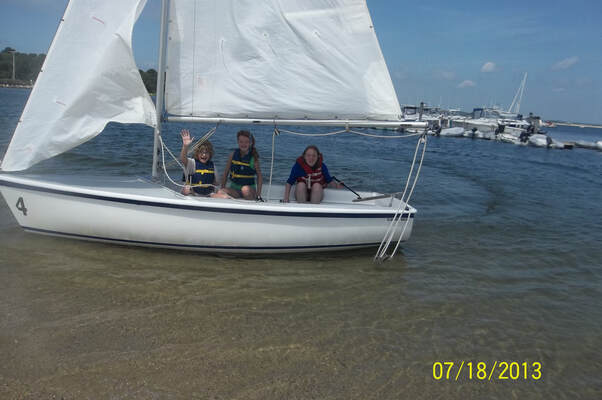 As a child, I spent my summers on Cape Cod. I took swimming lessons on the beach. My mom said that all year we used our brains in classrooms, so during the summer we should use our hands outside. Across the parking lot, there was a new sailing school. The next summer I was signed up with one of my little sisters. We were hooked. This program was called Bourne Community Boating. It was a half day, 4 week program, and one day a week was dedicated to science. We went on field trips to the Woods Hole Oceanographic Institute, and to Massachusetts Maritime Academy and to investigate local marine species and ecosystems. This summer camp has changed my life and the lives of others who attended the camp. One camper turned counselor spent a semester at sea and sailed to Fiji. Others joined sailing teams (Bourne HS joined with the next town) and continued to sail in college. Kids went on to study marine biology and environmental policy, things they were exposed to at BCB. My sister’s major is Marine and Fishery Sciences. I was first a camper, then an instructor in training, instructor, then head instructor. Over my 9 years there, I grew immensely. I discovered my love for teaching and practiced lesson planning and being flexible because sailing is so weather dependent. I met people with incredible stories, such as a family who hadn’t set foot on land in a year. I made lifelong friends who I didn’t see during the school year, but when we came back each summer, it was as if no time had passed at all. Very similar to HRMM’s sailing program, this was a community based program. We had barbecues, and there were scholarships available. We started an adaptive sailing program for individuals with physical or mental impairments which would make it more difficult for them to assess the water. We partnered with local veterans groups. It was awesome how this program was not competition focused, but promoted seamanship, caring for and understanding the environment around the water, and included people from all walks of life. I’ve been sailing for a number of years, but it wasn’t until I came to Kingston that I discovered the history around sailing. The Hudson River Maritime Museum is an awesome resource to find out how people have been interacting with the river for hundreds of years. The people I met at HRMM and in the Kingston Sailing Club are so welcoming and fun. This program is unique because we learn all of the things around sailing such as repairs/ woodwork. We learn the applications of sailing such as sail freight. There is such focus on environmentalism, and HRMM is actually doing something about improving the marine environment with Solaris and partnerships with Sloop Clearwater and Apollonia. If you would like to get connected with our amazing sailing community at the Hudson River Maritime Museum, visit our website, https://www.hrmm.org/sailing-school.html to learn more about sailing opportunities for youth and adults. Every Sunday in June we welcome you to join us for a painting class as you relax in the Wooden Boat School on the historic Kingston Waterfront. Students will enjoy an afternoon of instruction and leave with a finished 11x14 acrylic on canvas painting of the Stony Point Lighthouse. No experience is necessary and this class is open to anyone who wants to paint or is inspired by lighthouses. All materials are provided. Painter and instructor Catherine Buchanan will provide guidance as students create their works of art.
About the Instructor After studying art at San Francisco State University Catherine Buchanan worked photographing museum collections in California. She paints because she loves the challenge of creating lifelike images. Her series of large animal portraits showed in venues around San Francisco for many years and her dog paintings gained a wider audience after Pomegranate Press published a calendar. In 1999 she sailed to the South Pacific on a 40’ boat with a friend from Mexico to New Zealand, visiting more than forty islands on the way. In 2001 she moved ashore in American Samoa to open a thrift store and continue painting in the islands. Catherine is currently building her own house and painting in Kingston. www.catherinebuchanan.com. Hudson River Lighthouse Painting Series This class is one of a series, each featuring one of the 7 remaining lighthouses that dot the Hudson River: Hudson-Athens Lighthouse, Saugerties Lighthouse, Rondout Lighthouse, Esopus Meadows Lighthouse, Stony Point Lighthouse, Sleepy Hollow Lighthouse, and the Little Red Lighthouse. Separate registration is required for each class in the series. Dedicated painters who commit to 6 of the classes can attend their 7th class at no charge. A list of the classes can be found at www.hrmm.org/adult-classes. About Hudson River Lighthouses Of the dozens of lighthouses and lights that once dotted the Hudson River, only seven remain. This iconic American river, at the heart of the rise of New York City and westward expansion into the interior of the continent, was also a transportation super highway long before automobiles were invented. Throughout it all, the lighthouses kept watch, guarding the safety of the Hudson’s waterborne traffic. Tution General Public: $95 Members at Individual Level: $85 Members at Household Level & Above: $80 Materials: $20 (included at checkout) A happy young sailor on the Hudson River at AdventureSail, August 2021 According to Lea Maxwell in her blog from the website Escape Under Sail, “the lessons learned on the water in a sailboat, no matter what your age, are transformative. When your daughter learns to sail she gains an ocean full of perspective and skills. Lifelines that will be ever in reach as she bravely navigates a world that wrongly and too often whispers pretty instead of smart, optimistic, capable, happy.” Read more here : 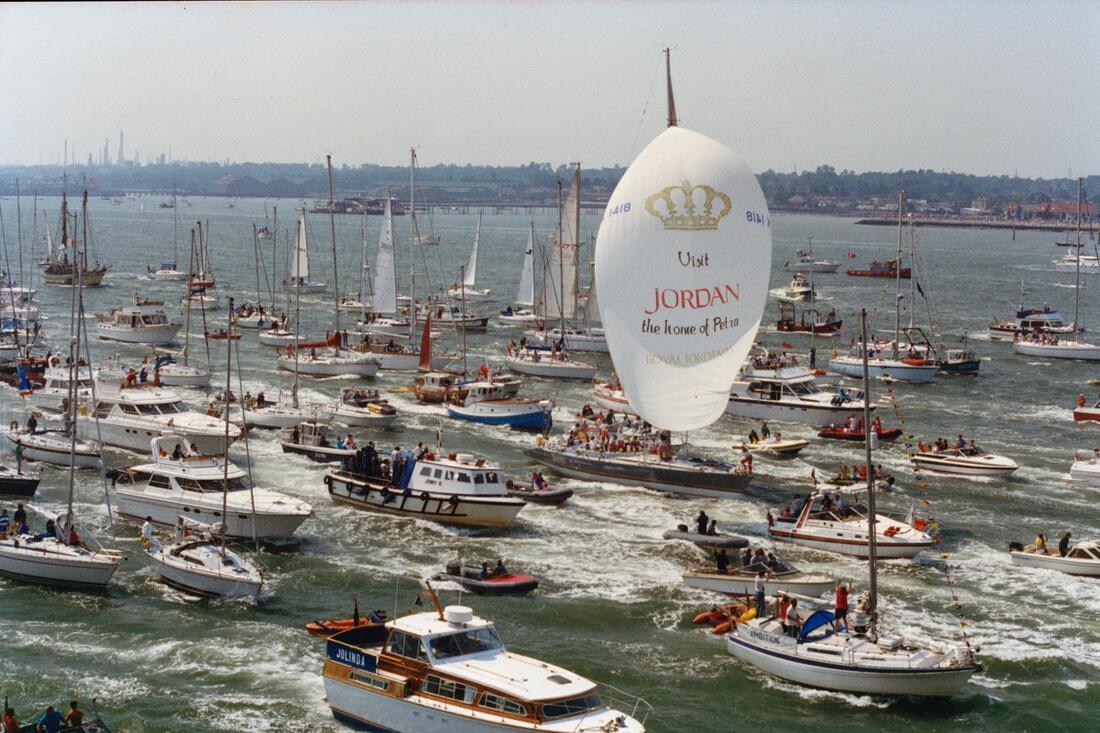 Don’t miss the chance to be inspired by the documentary film Maiden, which tells the true story of the all-women crew of Maiden, who completed the Whitbread Around the World Sailing Race in 1989-1990 against all the odds and cracked the glass ceiling for women sailors. The film will be shown in person at the Clearwater Barn at Hudson River Maritime Museum at 7 pm on Wednesday, May 18. Details and registration below. We are excited to announce "Nuts For Knots": a knot-tying workshop by high wire artist Philippe Petit Best known as the man who secretly rigged a wire between the towers of the World Trade Center, Philippe Petit has performed on the high wire at majestic sites all over the world, including Notre Dame, the Eiffel Tower, the Sydney Harbour Bridge, Lincoln Center and Grand Central Station. He personally rigs every wire on which he walks and has thus become a self-taught engineer and master rigger. His life depends on knots. “Nuts for Knots” will take place on Sunday, June 5, 2022 at the Hudson River Maritime Museum in Kingston, NY. Two workshop time slots are available, either 10AM-11:30AM, or 1:00-2:30PM. Each workshop has a maximum number of 14 participants so sign up soon to reserve your spot! Registration is $20 for individual tickets or two tickets for $35
The 41st Annual Snow Row at Hull, MAMarch 5, 2022, Hull, Massachusetts By Nelsie Aybar-Grau Nelsie will be presenting a lecture on Wednesday, April 27th, 2022 "Why I Love Rowing" Two years ago I booked myself a room at the Nantasket Beach Hotel so that I could attend the 41st Annual Snow Row in Hull, Massachusetts. I had just finished creating a one and a half hour PowerPoint called Waterways, Rowing and Regattas and in it I had included the 2016 Youtube drone video showing the Snow Row organized by the Hull Lifesaving Museum (HLM) in Hull, MA. Little did I know what would happen on the day that event was to have taken place. The race was cancelled due to COVID19 and I lost my hotel money. Even worse, the race did not take place until two years later on March 5th, 2022! Well, I finally got to attend and learned so much more about rowing than I knew when I made that PowerPoint two years ago. 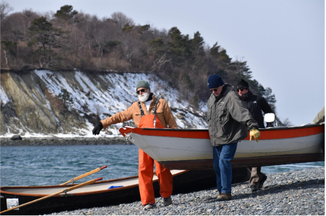 Ed McCabe helping move boats to the start line Ed McCabe helping move boats to the start line The Venue You would not expect the lovely, tiny town of Hull, MA, population 10,293, to host the most phenomenal rowing event. About half an hour away from Boston, MA, population 684,379, this event draws participants from as far away as Manhattan, New York, and all the way up to Belfast, Maine! The Snow Row is the idea of HLM which was founded in 1978. It has two fleets of boats, one at Windmill Point boathouse on the Hull peninsula (two pilot gigs and four Whitehalls) and another at the Boston Rowing Center on Fort Point Channel, (two pilot gigs and three Whitehalls). Because of this they have a robust open water rowing program. They even built four of the Whitehalls and two pilot gigs. Forty one years! That’s a lot of years, folks. You have to applaud a community that can pull off an event of this scope for such a length of time. Starting from a group of friends rowing their own boats to now a fleet of 11 boats! Kudos to the museum staff and volunteers but especially Ed McCabe, the only remaining founder who I saw there at the crack of dawn to help participants move their boats. 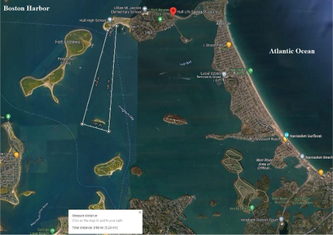 The Race Although the actual race start was at noon I got up before dawn to catch the sun rising on the Atlantic Ocean. It “felt like” 17 degrees but the sunrise on the spectacular 3 mile Nantasket Beach was well worth the braving the cold. Sadly there was no snow! It had snowed the week before a bit and I remember that in 2020 when I would have gone it would have been snowing. Nevertheless my crew and I were excited to be there finally and at 8:30 am we made it over to Windmill Point on the tip of the peninsula to see the rowers arrive and set up their boats along the narrow beach. 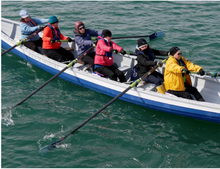 Women rowers in a pilot gig (six oars) Women rowers in a pilot gig (six oars) The Snow Row venue I have been to many “crew” rowing events like the Head of the Charles in Boston, the Dad Vail in Philadelphia and numerous scholastic division races in Poughkeepsie, near my home in Kingston, New York. In those races the spectators were friends of the rowers who were mostly either in high school or college rowing programs and their parents and, maybe, grandparents. Here, although some rowers were youngsters, the lion’s share were masters, i.e., parents, grandparents, empty nesters, retirees, seniors…you know what I mean? These frisky folks did not balk at an early rise or sub-freezing temperatures---they were bundled up and ready for anything! 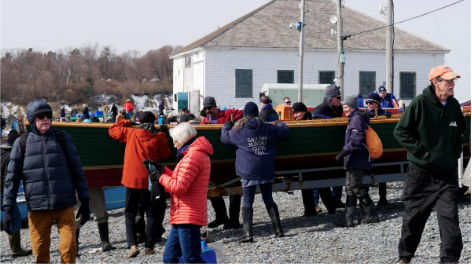 Moving a pilot gig to the start line Moving a pilot gig to the start line Their enthusiasm was infectious, and we would soon find ourselves lending a hand in the jockeying of boats on the start line. A half an hour before the noon start there was a swarm of people all over the beach and the spectator boat Massachusetts had over a hundred and twenty-five people packed into the stern clicking away with their cameras and cell phones as they waited for the announcer to count down the seconds to the start. The 219 registered rowers were in a state of heightened alert. The start is on the narrow stretch of beach sand around 390 feet wide southeast of the Windmill at the end of the Hull peninsula. I noticed the length because it reminded me of the beach where I launch at Kingston Point, which is about 420 ft wide. The first wave (there were three) of the 3.75-mile race would start with a horn blast and mad dash, Le Mans style, to the boats. Once there the crew members would back out (stern first) because the on-water launch means your rudder has to be submerged deep enough to prevent its damage. Then backpedaling (rowing) and turning the boats around made for chaotic splashing, sometimes clashing, of boats and oars until each vessel broke away for the dash to Sheep Island in Hingham Bay where they would turn and head back, around the day marker, and on to the finish. After 50 minutes most of the gig boats had returned but not until an hour and 23 minutes had passed would the last rower make it back to the beach. Then, of course, a party to celebrate before the long hall home (surprisingly both Belfast, ME, Kingston, NY and New York City are all about 4 ½ hours away). Boats, boats, boats !!! Boats. The sauce that makes this regatta so exceptional (besides the very friendly, adventuresome people you meet at these events)! The boats! Call them “traditional” or “classic” boats they are replicas built mostly by not-for-profit organizations. Some are made of wood and many use wooden oars also made by the same organizations. There are too many to cover in this piece but the four largest and most numerous where the Pilot Gigs, Whaling Boats, Whitehalls (or coxed 4), and the Currachs. Pilot Gigs The greatest number of race entries were the Pilot Gigs (I counted 14 on the race results page). Originating in Cornwall in the southern part of England pilot gigs were built for speed, endurance, and stability in rough seas. They are a hefty 32-feet long and about 4 feet 10 inches wide (built to a detailed specification from wood). Manned by six rowers and a coxswain they are heavy and imposing. 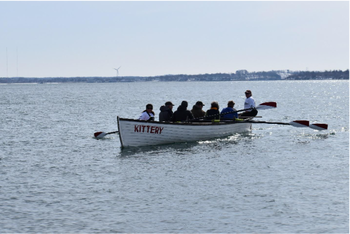 The pilot gig Kittery The pilot gig Kittery The HLM rowed a pilot gig in the race, the Kittery, built by rowers in Kittery, ME. It was coxed by Judy Flaherty. 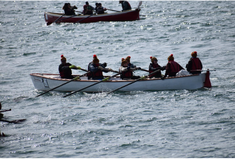 the pilot gig Norumbega the pilot gig Norumbega Another interesting pilot gig was Norumbega which belongs to Muriel Curtis. Muriel is the author of Come to Oars: Experiential Education on the Coast of Maine. And she runs StationMaine.org which teaches maritime skills such as sailing and rowing at no cost to young participants. 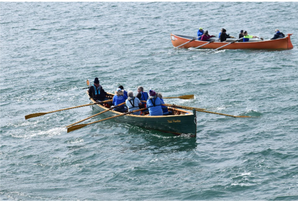 the pilot gig Mad Martha the pilot gig Mad Martha The Mad Martha (don’t you love the names!) belongs to the Massachusetts Bay Open Water Rowing Club out of Plymouth Harbor, MA. This club has 5 gigs and welcomes newbies. 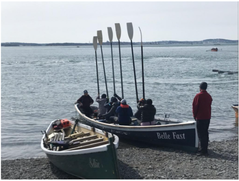 the pilot gig Belle Fast the pilot gig Belle Fast I want to mention Belle Fast and Selkie, pilot gigs hailing from Belfast, ME of course! They belong to the club Come Boating Belle Fast Maine. This club lists programs in sailing, rowing, youth rowing, pilot gig rowing, winter rowing and coxswain training. Whaling Boats! Although there were only three in the whaling boat category (the Skylark, the Flying Fish, and the Herman Melville), I have to say they blew me away. It is not something I had ever seen. All of the entries were from the Whaling City Rowing Club that rows off of Pope Island Marina in New Bedford, MA. In 1997 a group of people calling themselves "Whaleboats for the Whaling City" under the auspices of the Waterfront Historic Area League (WHALE) raised over $60,000 to build the three Beetle whaleboat replicas that are now used by the Whaling City Rowing Club. They are 28 ft long with a 6 ft beam. They weigh about 1000 lbs. empty. They require five rowers plus a coxswain. The coxswain stands at the stern and manages a long oar attached there. Three rowers on the starboard side and two rowers on the port side propel the boat forward. These boats remind me of the Spanish traineras that have a cox that stands at the stern of a 40 foot long boat with 13 rowers. Such boats are the norm in the Bay of Biscay up near France. Rowing in a trainera is at the top of my bucket list but now so is whaleboat rowing! 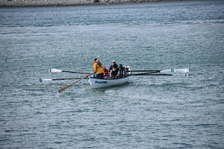 a whaling boat showing three starboard oars and two port oars a whaling boat showing three starboard oars and two port oars Whitehalls I am very familiar with the Whitehall as I have rowed the John Magnus, owned by the Hudson River Maritime Museum in Kingston, NY AND the Pete Seeger built and owned by the Village Community Boathouse (VCB) in New York City. The Whitehall was used as a rowing workboat in Boston, New York City, and, later, in San Francisco and likely evolved from the English Wherry. It is about 26 feet in length and carries four rowers and a coxswain. Balanced and swift it is the perfect boat for racing around any harbor. I believe there were seven Whitehalls in the Snow Row. They are mostly referred to as “coxed 4”s on the HLM race results page . The HLM Whitehall “Sacred Cod”, built by students in summer job training programs. Coxed by Corinne Leung, Director of Advancement & Communication at the HLM, the Sacred Cod has a cutout of a cod fish at the bow instead of the words “Sacred Cod”. It’s the only boat that has that distinction. HLM entries “Rescue”, coxed by Noel Blumenthal, and “Nobel”, coxed by Mike McGurl, executive director of the HLM, I was told are Whitehall loaners from VCB. Village Community Boathouse (VCB) entered two boats, a dory and a Whitehall. The Whitehall “Notorious GIG” was coxed by Dave Clayton. I must point out that not only does VCB have a wonderful rowing enterprise (their fleet consists of a total of 32 boats), youth programs built many of the Whitehalls in their eleven gig fleet. And they recently gifted a Whitehall, the “GML”, to the StationMaine.org in Rockland, Maine because they have too many boats AND because StationMaine.org is dedicated to offering boating opportunities at no cost to youth of all ages in the mid-coast Maine area. The Currachs or Curraghs Then there were I believe three Irish currach boat clubs. After asking around a bit I realized that the boats called “livery hov” boats are actually currachs. Anyway, these wooden boats sport four rowers without a coxswain (a 4- in crew parlance) and their oars look like, well, 2 by 4s. The oars attach to the boat with a triangular wooden piece. I found two clubs that entered the Snow Row with the currach: The Boston Currach Rowing Club and the Albany Irish Rowing Club. Both are members of the NACA, North American Currach Association which hosts regattas for currach clubs all over the nation. I never knew any of this! We were able to get a video of the Albany Irish Rowing Club as they launched their boat into the water. This is the clip https://youtu.be/JWCwa53jw98 . Since this club is only about an hour away from me I intend on rowing with them very soon! 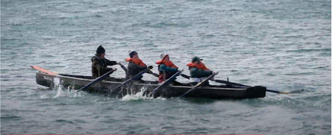 Rowers from the Albany Irish Rowing Club Rowers from the Albany Irish Rowing Club Get involved, no experience required! Finally I want to add that there were two other museums besides the Hull Lifesaving Museum that participated directly or indirectly in this event: the Cape Cod Maritime Museum and the Lake Champlain Maritime Museum. Most of these organizations welcome new people and would not mind letting you join a row if you contact them beforehand. I encourage you to do so. I plan to return to the HLM to row with them on a less hectic day than the high energy regatta that is the annual SNOW ROW. But I would love to row a currach and a whaleboat, so those two items jumped into my now very busy bucket list. And I look forward to telling you all about it! I started building light weight double paddle canoes when my 17 pound kevlar canoe began to feel too small. My first was a 13' by 28" beam skin-on-frame canoe. I loved the process. It was somehow freeing, relaxing. Since then I've taught people how to build these simple but elegant boats for twenty-five years. I still love seeing how proud people are after building a good looking, easy-to-use boat in just a few days. Many of these crafts have been used on lakes, ponds and rivers from Maine to Minnesota and down to Florida. And over the years, a number have appeared in the pages of WoodenBoat magazine. In the off season some lucky boats find their ways into homes where they rest on walls, and are sometimes hung from ceilings, to be enjoyed all winter. -Hilary Russell, Director of Berkshire Boat Building School and Author of Building Skin-on-Frame Double Paddle Canoes Want to build your own canoe with us this summer? Over the course of two weekends, June 17-19 & June 24-26, Instructor Rich Cerruto will lead this unique course on building skin-on-frame double paddle canoes. The canoe will be constructed with a wooden frame and a stretched with a nylon "skin". Each student will leave with a completed canoe ready for the water. These 28-pound canoes are strong and can hold up to 320 pounds. Easily car-topped, they are perfect for casual paddlers and beginning boatbuilders alike. Don't miss out on the opportunity to build your own beautiful functional canoe! The canoe is 30" wide, 10" deep, weighs about 32 lbs. and carries 320 lbs. Rig it as a solo, a tandem with a carrying yoke, or as a solo/tandem. All materials required are provided, including pre-cut lumber, polyester cloth, stem bands and seats.
Maiden is the famous 58 foot sloop captained by Tracy Edwards, MBE, which earned fame in 1990 when she competed with the first all-female crew in the Whitbread Around the World Race. The male-dominated worlds of sailing and media all doubted the crew would survive the first leg of the 45,000 nautical mile race, but not only did the boat and crew survive, they earned 2nd place overall in their class, the best result for a British boat in 17 years and unbeaten to this day.
Tracy Edwards’ story and Maiden’s story are amazing. You can meet Tracy and learn more about what compelled her to take on this incredible challenge, and how her experiences with Maiden and the crew have shaped her life’s work during a virtual lecture hosted by the Hudson River Maritime Museum (HRMM) on May 4, at 6 pm. Also, plan to view the 2019 documentary Maiden, which tells the compelling story of how the crew, led by Skipper Tracy Edwards, MBE, rebuilt their boat from the ground up and achieved great success on the race courses, overcoming tremendous challenges in the process. The film will be shown at the Clearwater Barn on the campus of the HRMM on May 18, 2022. Find information about the lecture and film and sign-ups here: https://www.hrmm.org/maiden.html. After many sailing achievements and awards, in 2017 Tracy Edwards set up The Maiden Factor Foundation to raise funds for and support efforts towards educating girls around the world. An extensive restoration project of the boat began, in the same yard in Hamble where she was refitted 30 years previously. The boat set sail in 2018, this time battling against the barriers that keep girls and other disenfranchised people out of education. The poorest girls in the poorest countries get just three years of schooling. Over the past 15 years the international community has worked to get them six, then nine. But this is still not enough. The Maiden Factor Foundation is working toward universal access to 12 years of fee-free, quality primary and secondary education for girls. For more information about how you can support the foundation’s efforts, please visit www.themaidenfactor.org Today, the famous vessel has resumed its world tour, which was interrupted in 2020 by Covid, and the boat is traveling to 40 destinations in 20 countries. Guess what? Kingston is on the list! The vessel will leave New York Harbor early on the morning of June 8, 2022, and she will be escorted up the Hudson River by a flotilla of boats to Kingston, where she is scheduled to arrive around 7 pm on Wednesday, June 8, 2022. On June 9 & 10, the Maiden crew will partner with the Hudson River Maritime Museum, the Sloop Clearwater, and the Sloop Apollonia to provide field trips for local schoolchildren to come to the Kingston waterfront, many for the first time, meet the crews, tour the boats, and participate in workshops in Science, Technology, Engineering and Math (STEM) topics related to sailing. These field trips will inspire and encourage children from our local community to pursue education and excel in their own learning journeys. The wider community will also be welcomed to meet the crew and tour the vessel. For information on how to support the Maiden’s visit to Kingston, join the flotilla, participate in youth field trips, or visit the boat and her crew, please go to: https://www.hrmm.org/maiden.html Have you ever wanted to learn to row, but were intimidated by the long, narrow rowing shells? Consider learning traditional rowing in a historic style boat like a Whitehall gig! Rowing instructor Nelsie Aybar-Grau can tell you more: Excerpt from My Row Around Manhattan, September 11, 2021 By Nelsie Aybar-Grau In the early nineteenth century, Whitehall rowboats were the choice of crimps (who would entrap men to work in shipping), boarding house runners (men who persuade sailors to leave a ship for better jobs that never materialize), and of anyone who required reliable and speedy transportation from one part of the harbor to another – pilots, ship’s crews, brokers, ship chandlers, newspaper reporters, insurance agents, doctors, police and many others. I have been rowing for 12 years, give or take. I row the Rondout Creek and Hudson River from Kingston, New York. I learned to row crew boats (the long, skinny, carbon fiber boats) with the Rondout Rowing Club. I was the president of the club for four years (2014 - 2017). The club would do an annual excursion from Kingston to Norrie Point, south of the Esopus Lighthouse and back. There we would meet up with rowers from the Mid-Hudson Rowing Association of Poughkeepsie. A few years ago the Hudson River Maritime Museum asked me to teach rowing to teens who were participating in the museum’s YouthBoat Project. While learning woodworking they were given the opportunity to row a Whitehall in the Rondout Creek. Most had never been on the water, and some did not know how to swim. But within minutes many got the hang of rowing and because, as cox I could compensate for those unable to keep up, we still managed to navigate the creek reasonably well. That is when I realized that the Whitehall is probably the best boat to use to teach anyone how to row. It is perfect for beginners and pros alike. For more of Nelsie's adventure, keep reading... Want to Learn to Row?Enjoy the historic Rondout Creek the way our ancestors did. Rowing has been pivotal to all working waterfronts for as long as people have taken to the water. Only last century was rowing replaced with motors as the main way to move people and goods around harbors and ports. Join us as we return to this tradition with a fun row on the creek. The museum's Rowing School offers several evening and afternoon classes in traditional rowing Did you know? HRMM members get discounts on all classes! Join today. Interested in learning more? Check out some of the classes and programs we offer below, for all ages and all experience levels.
Last fall, I spent hours collecting input from our sailing instructors and creating a list of replacement items and equipment needed to continue to run our Sailing School safely in 2022. The total was quite high, and I was seriously worried about how we would pay for these items. Then, surprise! In December, I learned our dedicated HRMM Boat School Volunteer Zef Fessenden pledged a targeted donation for The Sailing School equal to the amount on our list! Serendipity! We are so grateful for his support.
I asked Zef what motivated him to make this pledge. He told me that he learned to sail as a child on the North Shore of Long Island, and it changed his life. As an adult, he and his wife sailed many miles offshore and had amazing experiences and adventures. Even more important, Zef shared that sailing taught him so much about life. Zef’s lessons include: 1) We are not in control. Many of us think if we just work hard or we’re just lucky, we can control the outcome of our efforts, but sailors learn early in life, that is simply not true. Unexpected stuff happens often. Successful people understand that truth on land as well as on the water, and they develop their ability to cope with the unexpected. 2) The important thing is how we respond to life’s challenges. We can’t always predict a sudden squall, but we can handle it well or poorly. Similarly, in life, we often can’t control things like our health, income or difficult family members, but we can control how we react. If we take charge of what we can control and improve our lifestyle, we can regain our quality of life. 3) Preparation, knowledge and skill help us succeed. Though we don’t know in advance when we’re going to have a problem with equipment or weather, successful sailors build a tool chest full of practice, information, and techniques, which they dip into as needed in cases of unexpected challenges and emergencies. Preparation, knowledge and skill can be literally life-saving in sailing and in life in general. 4) Teamwork is a necessity. Whether your crew consists of two people or a full complement of eight or twelve people on a big racing keel boat, cooperation, communication, and trust in each other ensure that people aboard have a safe and positive experience. Sailing teaches us we need to depend on others and be dependable for others in order to survive and thrive in life. Zef wants other people, youth and adults, from various, diverse communities, to benefit from sailing as he did, so he is helping to make that happen. If you feel like Zef does, that learning to sail gifts people with a lifetime of self-confidence, skills, mental and physical fitness, leadership and cooperation, perhaps you would like to join him and make a targeted donation to the HRMM Sailing School or to one of the many other wonderful programs at HRMM. For 2022, we especially need support for scholarships to welcome new youth sailors from communities who have not had the opportunity to get out on the water before. If you are so moved, please support our youth sailing scholarships or other HRMM programs. Thank you! The author is Jody Sterling, Sailing School Director, HRMM |
AuthorStaff and volunteers of the Hudson River Maritime Museum's Wooden Boat School and Sailing & Rowing School. Archives
August 2023
Categories
All
|
|
GET IN TOUCH
Hudson River Maritime Museum
50 Rondout Landing Kingston, NY 12401 845-338-0071 info@hrmm.org Contact Us |
GET INVOLVED |
stay connected |
Proudly powered by Weebly

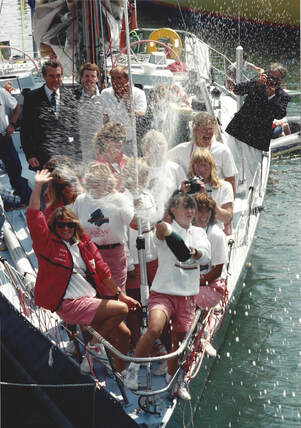
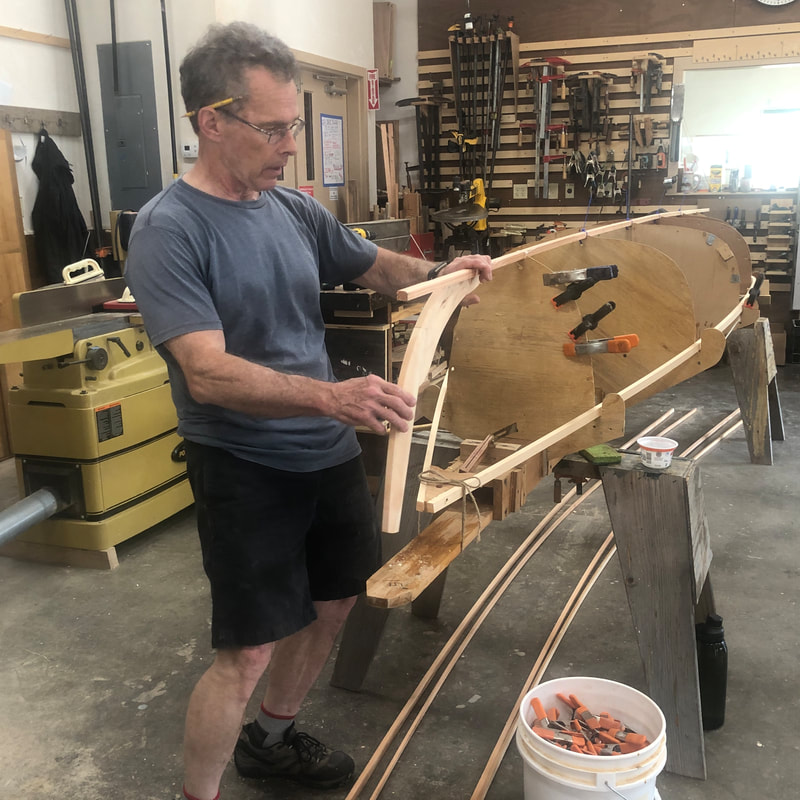
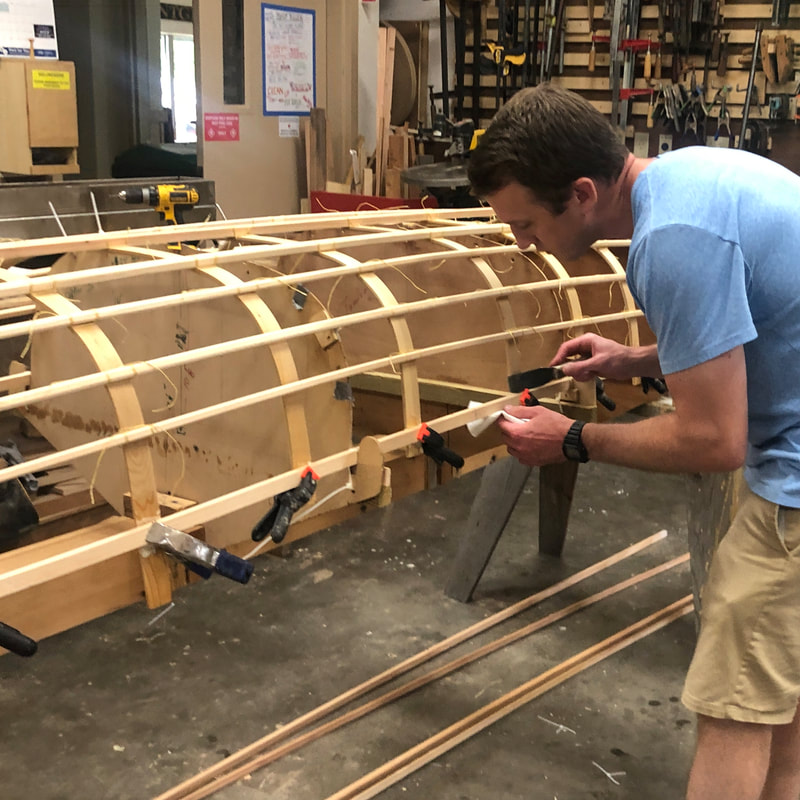
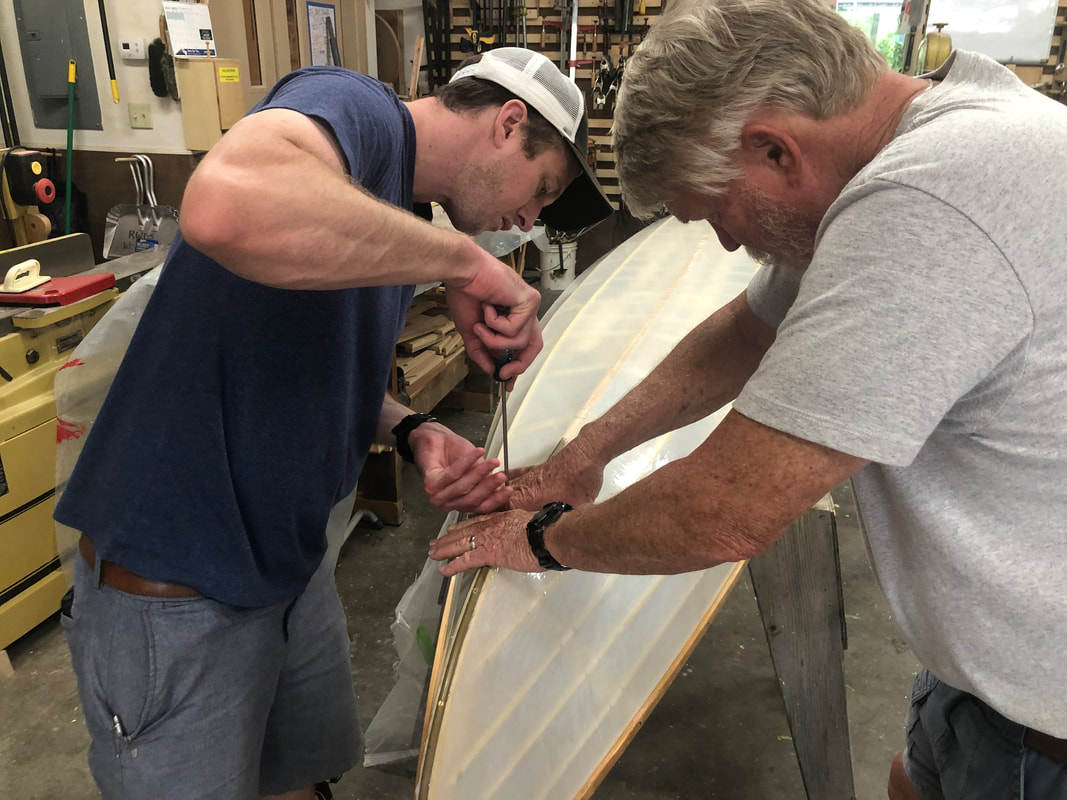
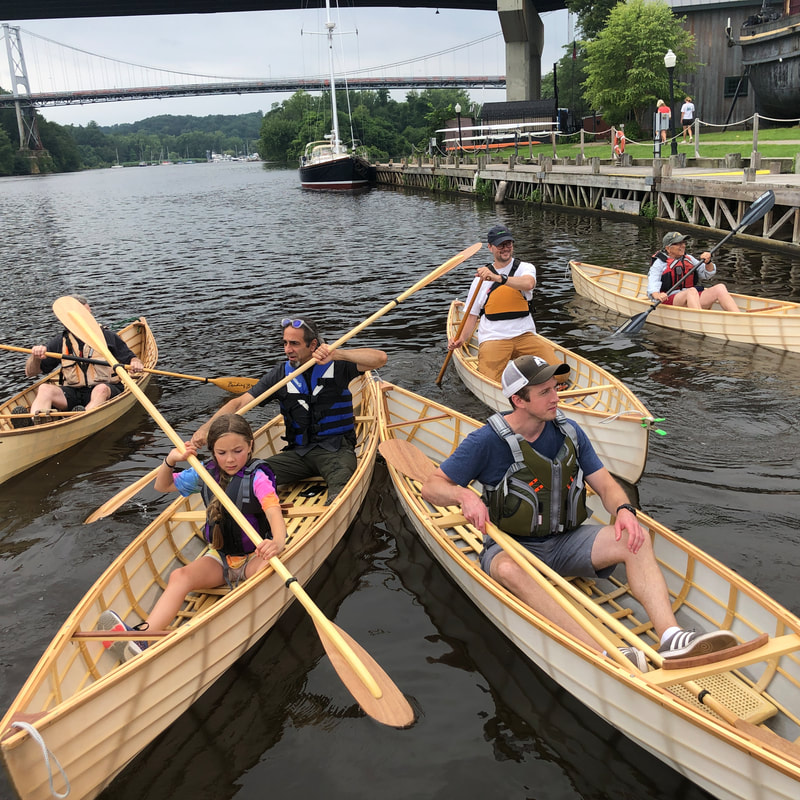
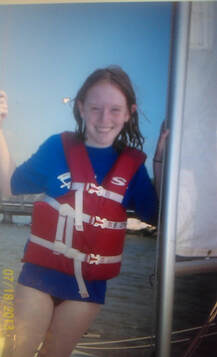
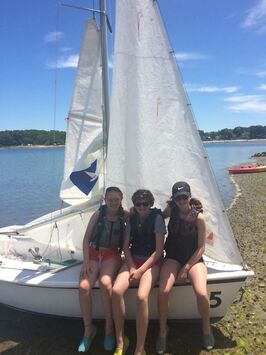
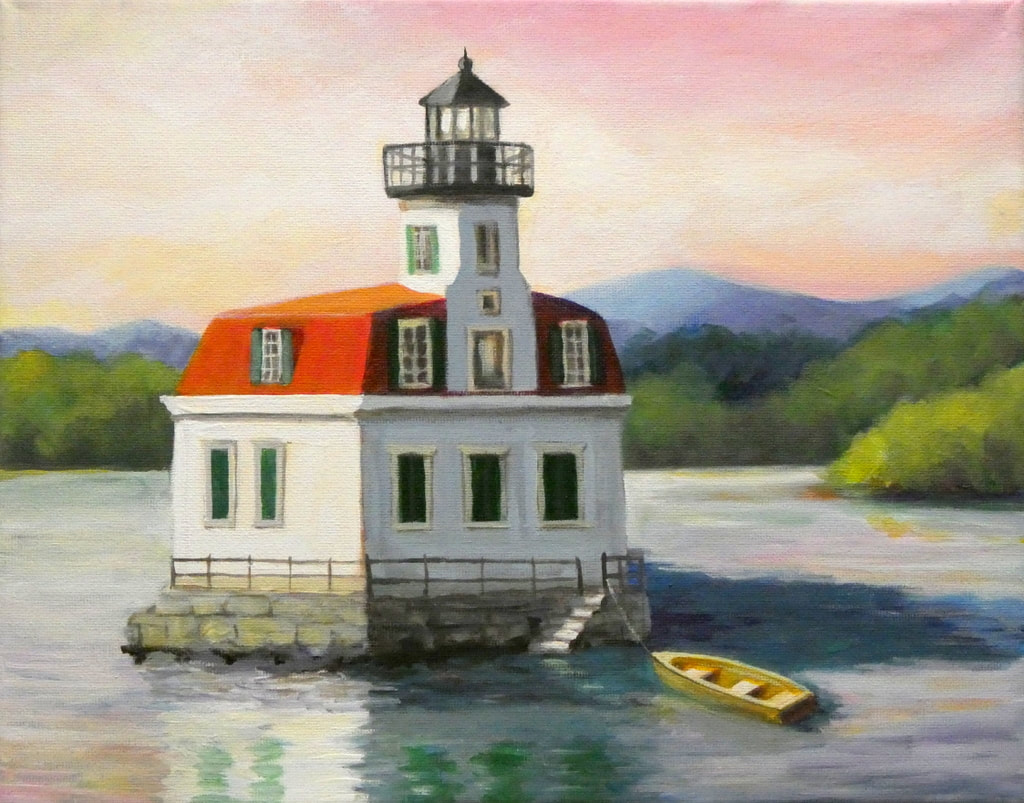
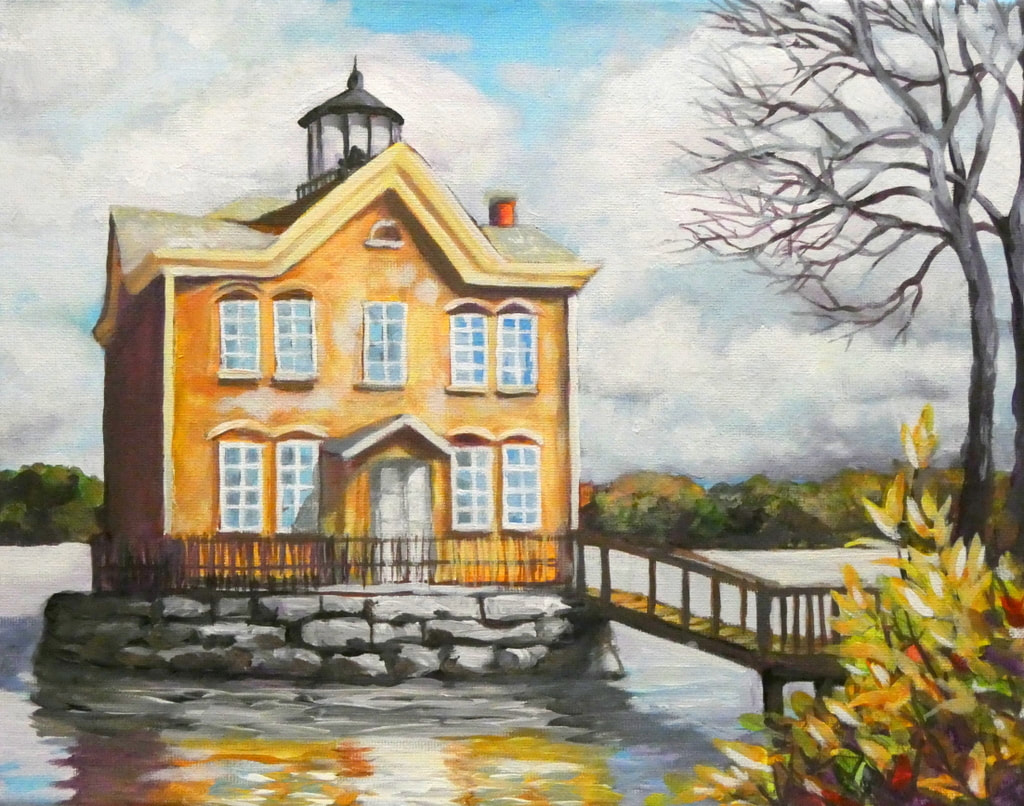
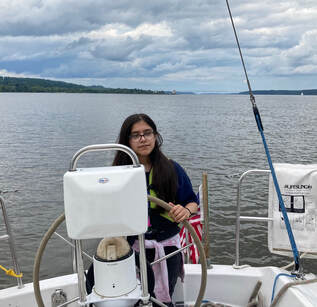
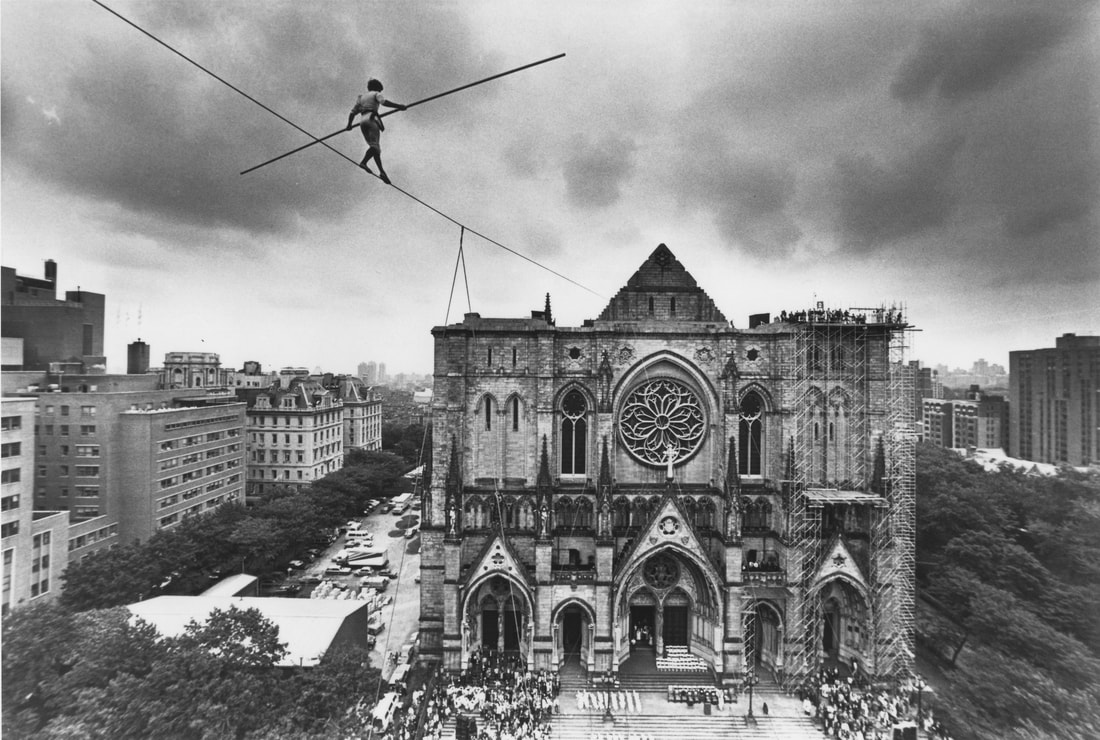
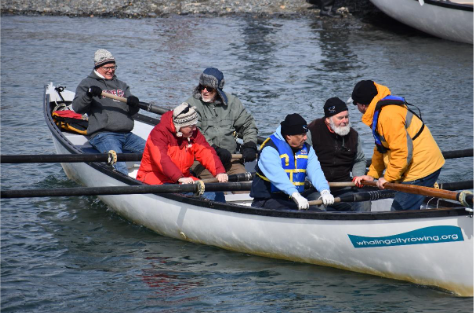
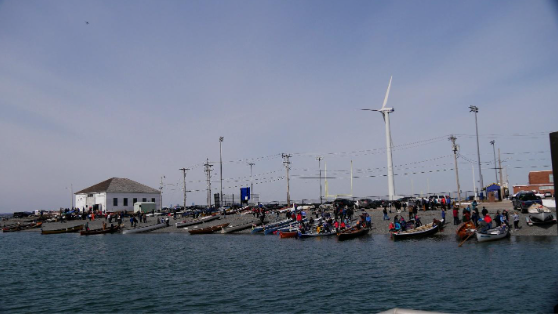
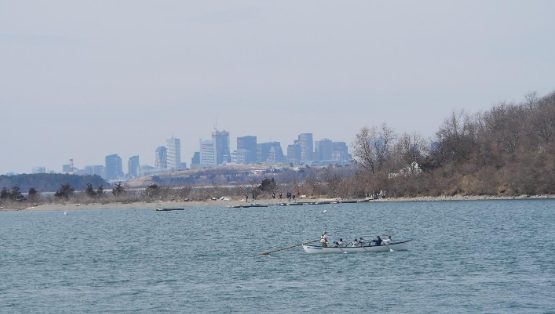
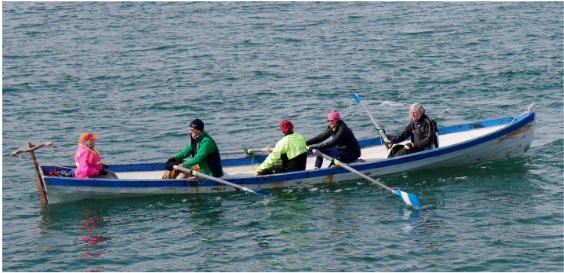
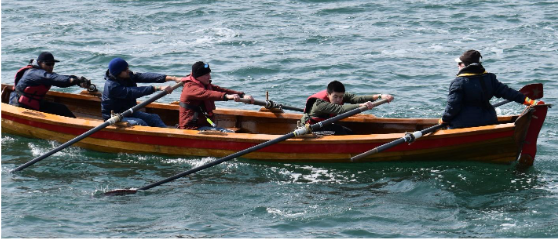
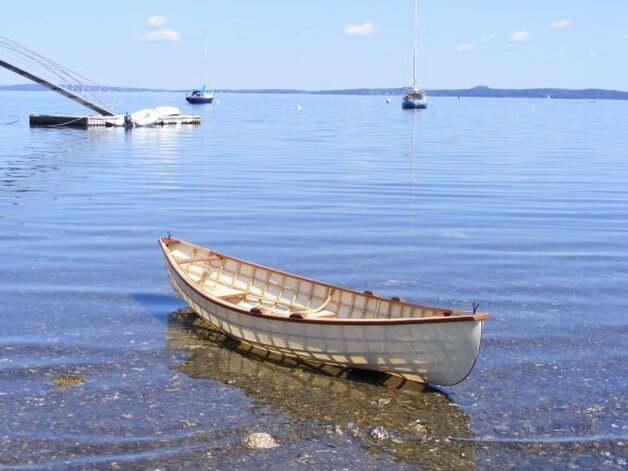
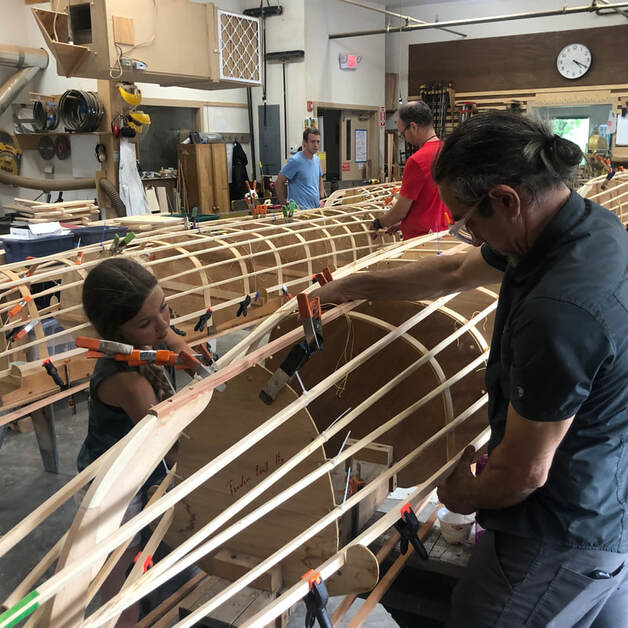
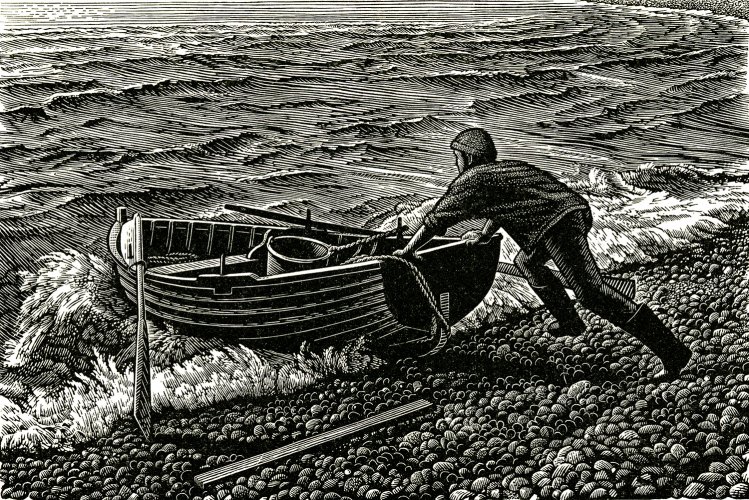
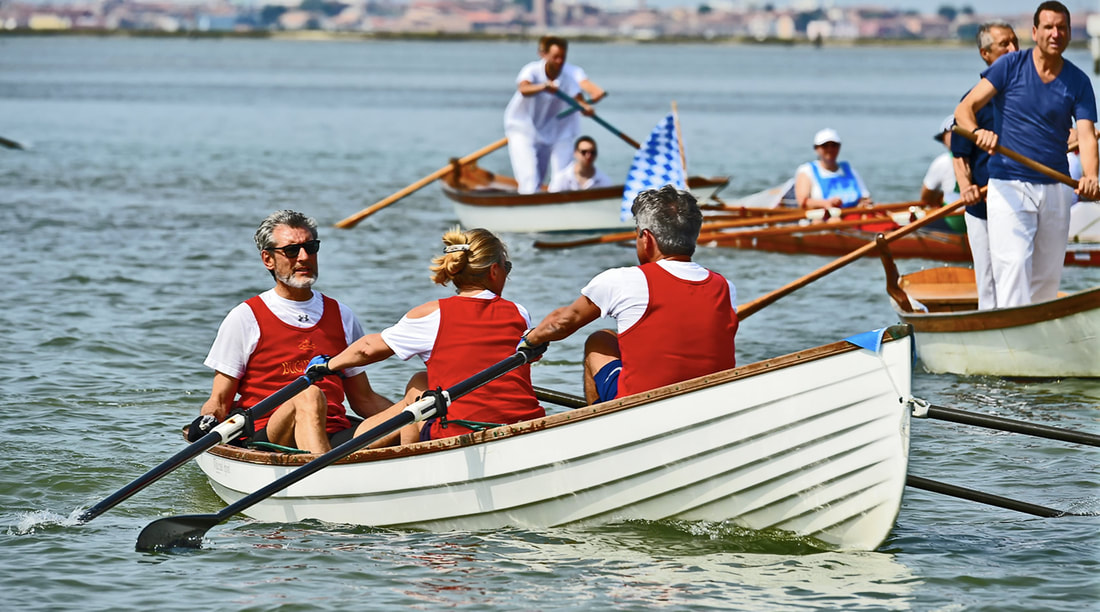
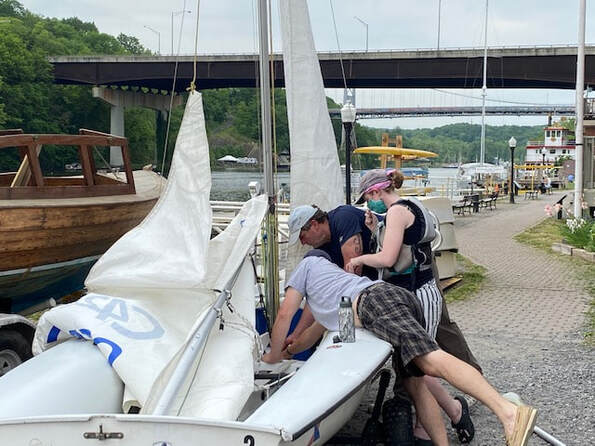
 RSS Feed
RSS Feed